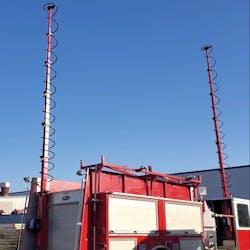NASA and DHS Team Up to Improve Firefighter Tracking Tech
As a veteran member of the fire service, Steven Vandewalle knows how vitally important it is for firefighters to be aware of their location and surroundings while battling a fire. He also knows how quickly that awareness can be thrown off amid the smoke and flames.
"You'd be tough finding a firefighter who doesn't have a story about getting lost during a fire," said Vandewalle, a member of the San Diego Fire Department.
In 1999, more than 70 firefighters responded to a massive blaze that erupted at the Worcester Cold Storage and Warehouse Co. in Massachusetts. As flames engulfed the nearly 95-year-old abandoned building, six firefighters became lost inside the maze-like structure, and they perished inside.
That dark day has been one of the driving forces behind a partnership between two federal agencies to develop new ways to keep firefighters oriented within a burning building and prevent such a tragedy from happening again. Researchers at NASA and the Department of Homeland Security (DHS) Science and Technology Directorate have teamed up to create the POINTER system, a more effective way to track firefighters at fire scenes.
"Location and tracking are the No. 1 priorities for the fire service," Greg Price, the DHS program manager for POINTER, told Firehouse.com about the project, which he has been developing with Darmin Arumugam, NASA's program manager for the system.
In the past, firefighters have used a variety of tracking technologies, such as GPS, to navigate structures during fire calls.
Those systems, however, have limitations that can affect the accuracy of the readings. For instance, GPS signals can have difficulties penetrating buildings and underground areas.
The POINTER system eliminates many of these issues by using magnetoquasistatic (MQS) fields, a type of magnetic field that can penetrate walls and other barriers that would hamper GPS and other tracking technology, Arumugam said. The penetrating power of MQS fields also means that a firefighter's location could be pinpointed down to centimeters as opposed to inches, a vital distinction when dealing with life-and-death scenarios. The ability to better locate a firefighter who might be disoriented or separated from his or her colleagues also saves another valuable resource: time. In the past, organized searches would have to be conducted in order to find a firefighter who might've been lost in a structure, said Vandewalle, who has been offering his experience and insight as a firefighter for the project. That could deplete a firefighter's air supply and still not result in determining a location.
"The beauty of this tech is its accuracy," Price said.
Here's how the POINTER system potentially would work in the field:
- MQS field transmitter masts would be deployed at a fire scene, and sensors would then map the space in three dimensions instead of two, giving incident commanders the ability to locate not only what level a firefighter might be on, but whether that individual is standing up or laying down.
- Firefighters would wear receivers that would pick up the MQS fields and relay that information to incident command.
- A visual interface would allow commanders to "see" the entire scene from a base station and pinpoint team members' locations.
"Never have I been so excited to see a dot on a screen before," Vandewalle said about the interface.
Although the POINTER system's operating principles are in place, researchers are still refining the field equipment. Transmitters and receivers need to be mobile, and they shouldn't significantly add to what firefighters already bring on calls.
"It has to be light," he said. "(Firefighters') PPE, in general, weighs a lot. It has to be small and light, something that could fit in your hand and be possible to set up on the go."
But how close is the promise of the POINTER system to becoming a life-saving reality?
"This kind of breaks my heart," said Price about project delays caused by COVID-19.
Originally, the goal was to have the system in the hands of firefighters by 2020. The new tentative schedule is to have prototypes and begin testing by the last quarter of 2022, Price said.
Even though the POINTER system has yet to be employed as a day-to-day tool for departments, Price and rumugam already see other uses for the technology. When used in the field, the system can record the information from a fire scene, and a playback function allows for after-action reviews that can be integrated into training for departments.
Other applications for the system include urban search and rescues, hostage situations and even commercial uses for the oil and gas industries.
"I think it's a fairly broad spectrum because it solves a problem that people haven't solved yet,"Arumugam said.


